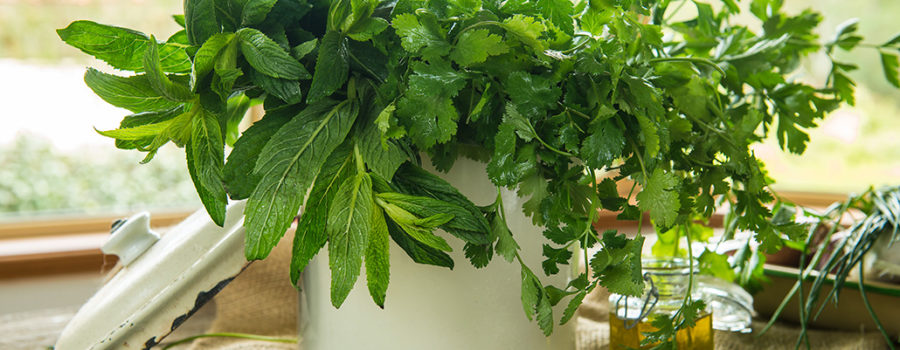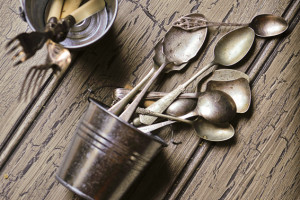Herb Garden Hints
 Return of the Herb Garden
Return of the Herb Garden
- Taking fresh looking tips from the herbs is the best way to stimulate new growth.
Globalization has expanded our taste buds and a growing curiosity towards new ethnic and exotic spices and herbs has many of us, using the less flavorsome dried or powder varieties which has been waiting on the shelves for weeks or even months.
A large segment of the market now want fresh herbs and spices for their intense flavor and amazing health benefits. You will grow your own natural medicine, boost your immunity and add delightful tastes to your dishes.
Why not join the huge trend and grow your own on the balcony, in pots or select a small garden bed in your garden.
Herb garden hints
- Your herb garden should, at the very least, receive 6 hours of sun a day.
- When planting out your herbs, leave adequate space between them for future growth.
- Don’t use tiny pots to grow your herbs in. Larger pots are better as they hold more moisture and nutrients
- You can store herbs easily in the freezer — just rinse, shake off excess water, and pop into cling film or a glass jar.
- Watch out for creeping, running or vigorous herbs that will take over the garden or planter.
- Regrow many of your herbs from your kitchen scraps
Turmeric a powerful superfood is a key spice in India curries. is natural anti-inflammatory, it inhibits the growth of new blood vessels in tumours and it’s a powerful antioxidant and curcumin content from the turmeric family may treat conditions like asthma, heart disease and cancer. Buy fresh turmeric and leave on the window sill until it starts to sprout. Plant into a pot with the sprout facing up to the light. Fresh turmeric is a absolute winner over the powder variety. You will never want to use powder turmeric again. Turmeric is easy to grow just leave to sprout and then re-plant.
Chia seeds are excellent for its omega 3 fatty acids that stabilize blood sugar, lower cholesterol and boost energy Chia seeds are cultivated from Saliva hispanica, a member of the mint family. You grow this plant as an annual herb and harvest the seeds when the flower pods have dried.
Garlic Greens, pungent garlic is a member of the cancer-fighting allium family. Its also linked to improvements in high blood pressure, high cholesterol, heart disease and cancer. Easy to grow, purchase a few garlic bulbs with small cloves and plant into a small pot with drainage holes. Break the garlic bulbs into individual cloves (leave the peel on). Water well and when the green shoots show cut with scissors and add to your cooking.
Basil has anti bacterial properties and unique flavonoids and can be easily grown from seeds and takes approximately 6 weeks to sprout. Best to regularly use the basil leaves. Basil plants like moist soil so keep them well watered. Sweet Basil is one of the most popular kitchen herbs around the world. Known for it’s anise-like flavor and intense clove-like aroma, Dried or fresh, basil is great for cooking or for creating an invigorating atmosphere anywhere in your home. Basil also offers several medicinal uses, including as a deodorizer, anti-arthritic, topical antioxidant, anti-inflammatory and an insect repellent. Basil provides us healthy doses of vitamins A, K, and C, as well as magnesium, iron, potassium, and calcium.
Lemongrass if you love using lemongrass but have a difficult time finding it, simply regrow your own. Lemongrass will grow just like regular grass. You just place the root that is leftover in a glass bowl or jar with enough water to cover it and leave it in the sunlight. After about a week, you will notice new growth and when this happens you can transplant your lemongrass in a pot or in your herb garden.
Ginger root is very easy to grow and once you get started, you can keep your supply of ginger full. You just need to plant a spare piece of your ginger root in potting soil, making sure that the buds are facing up. You will notice new shoots and new roots in about a week or so and once this happens you can pull it up and use it again. Remember to save a piece of the rhizome so that you can replant it and grow more for the next time you need it.
Growing fennel requires that you keep the roots intact. You need about an inch of the base of the fennel to get it to regrow. Just place this base in a container with about a cup of water and leave it in direct sunlight. The windowsill is the perfect place to grow fennel. When the roots grow strong and you notice new green shoots coming up from the center of the base, you can transplant into soil.
Basil is relatively easy to regrow. You just have to have a stem about four inches high. Place this stem in a glass of water with the leaves well above the water line. Leave the glass sitting in a bright area but not in direct sunlight. Roots should begin to form in a few days and when those roots reach a couple of inches long, you can transplant them in soil.
Cilantro also known as Coriander can be grown from scraps as well. Just place the bottom of the stem in a glass of water and leave in a bright area, near a windowsill perhaps. When the roots grow a couple of inches long, you can transplant the cilantro into a pot and you will notice new sprigs in just a few weeks. Cilantro is high in antioxidant vitamin C, as well as several vitamins and minerals. It is also a revitalizing herb that aids with digestion and relieves inflammation that may cause gastric upset. Coriander seeds are known to have a positive impact on blood sugar, reducing stress in the liver and pancreas which promote better production of insulin as well as improved digestion.
Chives grown from seeds by sowing indoors in your kitchen or directly outdoors. To get the most fresh chives from your plants, remember to harvest by cutting completely across the base of the plant, leaving about 1/2” (2cm) stubs above ground. Removing all of the leaves at once will encourage the plant to regrow. Preserve chives at the end of the season by drying or by adding fresh herbs to oil, butter, or vinegar.
Lavender is one of the most useful and herbal remedies, especially when its natural oils are distilled from the plant. Lavender can also be used in baking.Lavender is also insect repellant and a deterrent for mosquitoes. Grow your own lavender from seeds by sowing indoors, then transplanting outdoors in early spring. Lavender does not tolerate excessive moisture or humidity so it should be positioned at the top of a slope or high in a planting box. Lavender also does well in containers for this reason, also. Lavender blooms in the summertime. To encourage flowering all season long, clip blooms regularly either for herbal use or to dead-head once they begin to wilt. Lavender also benefits from light pruning in the spring after the first new growth appears.
Lemon Balm naturally eases nerve and muscle tension. The fresh herb can be used as poultice to reduce inflammation and prevent infection. Because of its anti-viral properties, lemon balm may be applied to reduce the healing time of cold sores. When ingested, lemon balm relieves gas, cramping, and stomach upset. Lemon balm tea is often consumed to promote relation, mental clarity, and alertness. Add fresh lemon balm leaves to salads to spice up your greens with a refreshing citrus kick. Lemon balm is also a natural repellant for flying insects. Grow your own from seed by sowing indoors, then transplanting outdoors in spring or fall. To harvest, lemon balm is one of only a few herbs which may be cut back to rejuvenate.
Oregano leaves can be used to treat respiratory maladies, digestive upset, parasitic infections including fungal infections, skin conditions including dandruff and psoriasis, muscle aches and join pain. Oregano is also a natural insect repellant.In cooking, Oregano is often used for Mediterranean cuisine. Grow your own indoors, then transplanting outdoors in early spring. When harvesting, remember that both Oregano leaves and flowers are edible and possess similar flavors.
Parsley grow your own seed by sowing indoors, then transplanting outdoors in early spring. Mulch around plants to keep soil moist, but avoid letting mulch touch the stems to prevent rot. To promote thicker foliage, cut parsley down to stems. Parsley is also a powerful antioxidant and anti-inflammatory which makes it great for digestion and detoxification. Though pregnant women should stay away from this herb as parsley is also known to induce uterine contractions and can cause miscarriage.
Peppermint is an excellent deterrent for many kinds of pests including rodents, ants and spiders Plant this pungent herb around your home and garden to keep harmful critters at bay. As an herbal remedy, peppermint tea can help to clear sinus congestion, soothe a headache, relax you after a hard day, or help you to stay alert without feeling wound up. The natural oils in peppermint act as a digestive aid. Grow your own peppermint from seed by sowing indoors, then transplanting outside at anytime up to 2 weeks prior to first frost. Peppermint seeds may also be direct sown outdoors and do not need to be covered with soil. Most mint seeds actually germinate better with no soil covering at all as they require lots of light to stimulate them out of dormancy. Peppermint is one of the easiest herbs to grow.
Rosemary is also a powerful natural remedy for soothing indigestion, neutralizing bad breath, and relieving pain. Use rosemary oil or herb-infused water to clear up dandruff, promote hair growth, and relieve skin irritation. The aroma of rosemary can help to clear the mind, quiet anxiety, and relieve everyday stress. Rosemary is much easier to grow from clippings as the germination rate of its seeds is very low. Rosemary does well with mulch to keep roots moist in summer and insulated in winter.
Sage-infused tea is an effective herbal remedy to reverse greying of hair, reduce fever, and calm anxiety from brain and nervous disorders. Sage tea can also be used to soothe gastric ailments brought on by stress and to treat infections of the mouth and throat. Grow your own sage from seeds or propagated from cuttings. Sage may also be sown directly outside in the springtime.
Tarragon is an excellent source of many vitamins and minerals, including antioxidants vitamin C and vitamin A, magnesium, iron, zinc, and calcium. In addition, an herbal tea made from fresh tarragon can help to calm anxiety, kill germs that cause bad breath, and suppress the appetite. Drinking tarragon tea or chewing on fresh tarragon leaves can also be an effective numbing agent for mouth pain. Because of its anti-bacterial properties, oil distilled from tarragon can also be used in formulating natural deodorants. Tarragon can also be easily propagated from cuttings and will spread quickly if live stems are allowed to droop to the ground. This herb does great in pots and requires very little maintenance.
For further information check out Naturallivingideas.com





